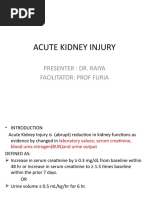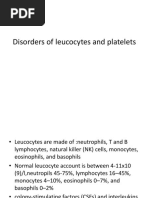0 ratings0% found this document useful (0 votes)
34 viewsAcute and Chronic Kidney Disease
Acute and Chronic Kidney Disease
Uploaded by
Samuel kuriaThis document discusses acute kidney injury and chronic kidney disease. It covers the pathophysiology, management, investigations and treatment of AKI, stages and causes of CKD, signs and symptoms of CKD, and supportive treatments for CKD including diet, controlling blood pressure and diabetes, treating anemia and bone disease, and use of diuretics and dialysis.
Copyright:
© All Rights Reserved
Available Formats
Download as PDF, TXT or read online from Scribd
Acute and Chronic Kidney Disease
Acute and Chronic Kidney Disease
Uploaded by
Samuel kuria0 ratings0% found this document useful (0 votes)
34 views17 pagesThis document discusses acute kidney injury and chronic kidney disease. It covers the pathophysiology, management, investigations and treatment of AKI, stages and causes of CKD, signs and symptoms of CKD, and supportive treatments for CKD including diet, controlling blood pressure and diabetes, treating anemia and bone disease, and use of diuretics and dialysis.
Original Description:
medicine
Original Title
Aki-ckd
Copyright
© © All Rights Reserved
Available Formats
PDF, TXT or read online from Scribd
Share this document
Did you find this document useful?
Is this content inappropriate?
This document discusses acute kidney injury and chronic kidney disease. It covers the pathophysiology, management, investigations and treatment of AKI, stages and causes of CKD, signs and symptoms of CKD, and supportive treatments for CKD including diet, controlling blood pressure and diabetes, treating anemia and bone disease, and use of diuretics and dialysis.
Copyright:
© All Rights Reserved
Available Formats
Download as PDF, TXT or read online from Scribd
Download as pdf or txt
0 ratings0% found this document useful (0 votes)
34 views17 pagesAcute and Chronic Kidney Disease
Acute and Chronic Kidney Disease
Uploaded by
Samuel kuriaThis document discusses acute kidney injury and chronic kidney disease. It covers the pathophysiology, management, investigations and treatment of AKI, stages and causes of CKD, signs and symptoms of CKD, and supportive treatments for CKD including diet, controlling blood pressure and diabetes, treating anemia and bone disease, and use of diuretics and dialysis.
Copyright:
© All Rights Reserved
Available Formats
Download as PDF, TXT or read online from Scribd
Download as pdf or txt
You are on page 1of 17
Acute and chronic kidney disease
Acute kidney injury
• Rapid ,<48hours deterioration/impairment of
kidney function resulting in the retention of
nitrogenous and other waste products
normally cleared by the kidneys
• creatinine clearance going down >50% and or
creatinine increasing more than 0.3mg/dl or
urine output less than 0.5ml/g/hr for 6 hours
pathophysiology
• With renal hypoperfusion from decreased cardiac
output or low blood pressure vasoconstriction of
efferent arteries occurs.
• This is mediated by renin-angiotension-aldosterone
axis,vasopressin and sympathetic system.this way
glomerular filtration can be maintained even with
hypoperfusion.
• Afferent vasodilation also occurs via nitric oxide and
prostaglandins maintaining glomerular perfusion
• This autoregualtion fails if prolonged and when BP fall
to less than 80mmhg systolic hence AKI
management
• Treat underling cause eg sepsis,heart failure,GE
• Avoid nephrotoxic insults e.g drugs
• Optimize bp,keep MAP(>60mmhg)
• Watch for electrolytes and fluid balance
• Relieve obstruction if present
• Indication for acute dialysis
• Acid base abnormalities-metabolic acidosis
• Electrolyte e.g hyperkalemea,hypercalcemea,
• Fluid overload-pulmonary edema
• Uremea-pericarditis,encephalopathy,bleeding
Investigations-AKI/CKD
• Serial Urinalysis,urine output,osmolarity
• Fractional excretion of sodium e.g <1% in pre-
renal vs >2% in acute tubular necrosis
• Urea,electrolte and creatinine
• Calcium,phosphatevitamin D,parathyroid levels
hemoglobin normal in AKI abnormal in CKD
• Serologies-looking for glomerular disease eg
HIV,ANA,HEPB/C,P-ANCA.C-ANCA etc
• Renal ultrasound-size of kidneys,normal in
Aki,small in CKD
CKD
• >3 months of reduced glomerular function of
<60ml/min and or renal damage
(imaging,pathology,markers)
Stages of CKD
aetiology
• Diabetic glomerular disease
• Glomerulonephritis eg post
streptococcal,connective tissue disease,
• Hypertensive nephropathy
Primary glomerulopathy with hypertension
Vascular and ischemic renal disease
• Autosomal dominant polycystic kidney disease
• Other cystic and tubulointerstitial nephropathy
• Urological causes-BPHH,bladder tumor
Signs and smptoms
• Majority are asymptomatic till late
• Uremic syndrome from urea other waste
products accumulation cause symptoms late on
• General-nausea,anorexia,malaise,fetor
• Skin-uremic frost,pruritus
• Neurologic-encephalopathy(decreased mental
status,memory,attention)seizures,neuropathy
• Cardiovascular-pericarditis,
LVH,hypertension,cardiomyopathy,CAD,heart
failure
• Haematology-anemia,bleeding,thrombocytopnea
• Metabolic-hyperkalemea,acidosis
• Bone mineral disease-
hypocalcemea,hyperphosphotemea results in
hyperparathyroidism :osteoarthropathy with osteitis
fibrosa cystica,adynamic bone disease,osteomalacia
• Endocrine-sexual dysfunction,low VITD,impaired
growth and development,infertility
• Other manifestation-fluid retention,acid-base
abnormalities ,dyslipidemea
• Systemic inflammation-low
albumin,cachexia,accelerated atherosclerosis
• Anemea is universal at stage 4 and 5 CKD
– Reduced erythropeitin production by kidneys
– Increased bleeding due to uremea
– Reduced levels of haematinics-fe,B2,folate
– Iron deficiency
– Reduced RBC survival span
– Comorbidities-autoimmune,HIV,drugs etc
– Hyperparathyroidism and bone marrow fibrosis
– Chronic inflammation
treatment
• Supportive-
– Diet-low salt diet,low phosphate,low potassium
– Control DM HBA1C <7%
– HTN-BP 130/80 ACE-I/ARB if not hyperkelemic and
creatinine <250mmol/l
– Anemia-target HGB 11-12g/dl erythropoetin injection
with injection iron
– Secondary hyperparathyroidism -from low
calcitriol,calcium and high phosphate causing
osteodystrophy
– If calcium low and phosphate high use calcium
carbonate(actal tums) or phosphate binders eg sevelamer
– Vitamin D (calcitriol)
• Diuresis
– Loop diuretics eg furosemide 40mg bd-tid,torsemide
20mg.a/e-hypokalemea,hyponatremea,hypocalcemea
– Thiazide –HCTZ 25mg metolazone 2.5mg.as above but
hypercalcemea,hyperlipidemea,hyperuricemea
– Mineralocorticoid inhibitor-
spirinolactone.hyperkalemea,gnacomastia
• Dialysis-water,toxins and electrolytes control
– Perioteneal dialysis and haemodialysis
• Renal transplant
You might also like
- Lifestyle Incurable Diseases enDocument557 pagesLifestyle Incurable Diseases enJairo Suriel100% (1)
- PNLE: Maternal and Child Health Nursing Exam 3Document41 pagesPNLE: Maternal and Child Health Nursing Exam 3Lot Rosit50% (2)
- EMQs For Medical Students Volume 3 PDFDocument15 pagesEMQs For Medical Students Volume 3 PDFAbdulaziz Al-Araifi0% (1)
- 1 - Fluid and Electrolytes (Schwartz Based)Document52 pages1 - Fluid and Electrolytes (Schwartz Based)Alexandra RebosuraNo ratings yet
- Kidneys, L300Document44 pagesKidneys, L300Ko JoNo ratings yet
- Electrolyte Imbalances and Their Management.: by Nabawanda Saluwa Facilitator: DR - Ssebuliba MosesDocument44 pagesElectrolyte Imbalances and Their Management.: by Nabawanda Saluwa Facilitator: DR - Ssebuliba MosesNinaNo ratings yet
- Aki & CKD 2024Document68 pagesAki & CKD 2024AhemigishaNo ratings yet
- Hypokalaemia and HyperkalaemiaDocument39 pagesHypokalaemia and HyperkalaemiaRZ NgNo ratings yet
- Chronic Renal Failure (CRF)Document37 pagesChronic Renal Failure (CRF)sivaNo ratings yet
- Chronic Kidney DiseaseDocument35 pagesChronic Kidney DiseaseNur'ain Nabila100% (2)
- Acute Chronic Kidney InjuryDocument29 pagesAcute Chronic Kidney InjuryPriya GKNo ratings yet
- Acute Renal Failure: DR Grania PriceDocument24 pagesAcute Renal Failure: DR Grania PriceCastro KisuuleNo ratings yet
- ARF. Lec, QIMS - For Medical StudentsDocument38 pagesARF. Lec, QIMS - For Medical StudentscodewithibfNo ratings yet
- Pathogenesis and Management of Renal Failure and Replacement Therapy For Stage V Chronic Renal DiseaseDocument30 pagesPathogenesis and Management of Renal Failure and Replacement Therapy For Stage V Chronic Renal DiseaseByzantine Wulandari ParubakNo ratings yet
- 7.acute Renal Failure (ARF)Document20 pages7.acute Renal Failure (ARF)Mahesh RathnayakeNo ratings yet
- AKIDocument22 pagesAKISatyabrata SinghNo ratings yet
- Renal Failure March 2020Document46 pagesRenal Failure March 2020dicksonsamboNo ratings yet
- Chronic Renal Failure: DR Vasudeva Upadhyaya, St. Johns Medical College Bangalore DR Ravi Bhat, SDM DharwadDocument38 pagesChronic Renal Failure: DR Vasudeva Upadhyaya, St. Johns Medical College Bangalore DR Ravi Bhat, SDM Dharwadasharhasan81No ratings yet
- Chronic Kidney DiseaseDocument18 pagesChronic Kidney Diseasephylliswambua661No ratings yet
- Acute Kidney Injury (AKI) :: FeaturesDocument3 pagesAcute Kidney Injury (AKI) :: FeaturesDavid PerezNo ratings yet
- Nephrotic Syndrome + ArfDocument64 pagesNephrotic Syndrome + ArfkrishnasreeNo ratings yet
- Acute Kidney Failure: Dr. Syamsudin, M.Biomed Fakultas Farmasi Universitas PancasilaDocument48 pagesAcute Kidney Failure: Dr. Syamsudin, M.Biomed Fakultas Farmasi Universitas PancasilariyuNo ratings yet
- Acute Kidney InjuryDocument54 pagesAcute Kidney InjuryggplabonNo ratings yet
- Renal Diseases " Review "Document22 pagesRenal Diseases " Review "api-3827876No ratings yet
- Plications of HemodialysisDocument30 pagesPlications of HemodialysisAISHWARYA T DNo ratings yet
- B. Acute Kidney InjuryDocument38 pagesB. Acute Kidney InjuryRachman RhizaNo ratings yet
- Chronic Kidney DiseaseDocument6 pagesChronic Kidney Diseaseashi leginNo ratings yet
- Session 24 Heart FailureDocument15 pagesSession 24 Heart FailuregwivahamaikoNo ratings yet
- Gagal Ginjal Kronik: Jainuri Erik Pratama, M.Farm - Klin., AptDocument30 pagesGagal Ginjal Kronik: Jainuri Erik Pratama, M.Farm - Klin., ApthudayanaNo ratings yet
- Renal NotesDocument11 pagesRenal NotesPatty Pasarilla Passehl100% (2)
- 10 Renal FailureDocument32 pages10 Renal Failureyabais110No ratings yet
- Management of Acute Kidney InjuryDocument31 pagesManagement of Acute Kidney InjurysumitNo ratings yet
- Acute Renal FailureDocument45 pagesAcute Renal FailureRubinNo ratings yet
- Renal Function TestsDocument34 pagesRenal Function TestsMandavi HindNo ratings yet
- Lecture 3 CKDDocument53 pagesLecture 3 CKDPharmswipe KenyaNo ratings yet
- Haematological DisordersDocument28 pagesHaematological DisordersSamuel kuriaNo ratings yet
- Renal Failure PresentationDocument110 pagesRenal Failure PresentationMusa yohana100% (2)
- PathophysiologyDocument39 pagesPathophysiologymawialsaadawyNo ratings yet
- Chronic Kidney DiseaseDocument12 pagesChronic Kidney DiseaseabdurabengNo ratings yet
- Acute Kidney Injury (Acute Renal Failure)Document21 pagesAcute Kidney Injury (Acute Renal Failure)phylliswambua661No ratings yet
- Anaesthesia For Liver DieseaseDocument43 pagesAnaesthesia For Liver DieseaseShehan WijayasiriwardanaNo ratings yet
- Renal Faliure 1Document50 pagesRenal Faliure 1180045No ratings yet
- Acute Kidney Injury (AKI) : by Prof Grace Irimu Consultant Pediatrician and NephrologistDocument43 pagesAcute Kidney Injury (AKI) : by Prof Grace Irimu Consultant Pediatrician and Nephrologistokwadha simionNo ratings yet
- CKD Tipus UJianDocument28 pagesCKD Tipus UJianevanatalia29No ratings yet
- Presentation مسنين عمليDocument19 pagesPresentation مسنين عمليzoubia209No ratings yet
- Fluid and Electrolyte Balance (Rama)Document56 pagesFluid and Electrolyte Balance (Rama)rafiq eimanNo ratings yet
- Systolic Heart FailureDocument66 pagesSystolic Heart FailureFerinaTarizaIINo ratings yet
- Acute Kidney InjuryDocument23 pagesAcute Kidney InjuryBaraka SayoreNo ratings yet
- Renal FailureDocument21 pagesRenal Failureapi-3731294100% (2)
- Chronic Kidney Disease: Pembimbing: Dr. Pit Lan, SPPDDocument25 pagesChronic Kidney Disease: Pembimbing: Dr. Pit Lan, SPPDAnita ZhangNo ratings yet
- Healthy FoodDocument16 pagesHealthy Foodbearp3092No ratings yet
- Fluid & Electrolyte ImbalanceDocument37 pagesFluid & Electrolyte ImbalanceoutkastedNo ratings yet
- Definition-Acute Kidney InjuryDocument6 pagesDefinition-Acute Kidney Injuryashi leginNo ratings yet
- Renal Disease Management DPS 103 Jul 2022Document26 pagesRenal Disease Management DPS 103 Jul 2022spicebunny20No ratings yet
- Acute Kidney InjuryDocument30 pagesAcute Kidney InjuryNidhi JamesNo ratings yet
- AscitesDocument46 pagesAscitesRahul Kumar VermaNo ratings yet
- Chronic Kidney Disease (End-Stage Renal Disease)Document42 pagesChronic Kidney Disease (End-Stage Renal Disease)mercybiwott20No ratings yet
- Chronic Renal FailureDocument3 pagesChronic Renal FailureJashine DajayNo ratings yet
- UNIT 3.1 - AHN - Fluid & Electrolyte ImbalanceDocument31 pagesUNIT 3.1 - AHN - Fluid & Electrolyte Imbalanceannududi378556No ratings yet
- Renal Failure Acute and Chronic: NPN 200 Medical Surgical Nursing IDocument31 pagesRenal Failure Acute and Chronic: NPN 200 Medical Surgical Nursing IJuan ValadezNo ratings yet
- The Renal Diet Kitchen: 60+ Quick and Delicious Renal Diet Recipes to Improve Kidney FunctionFrom EverandThe Renal Diet Kitchen: 60+ Quick and Delicious Renal Diet Recipes to Improve Kidney FunctionNo ratings yet
- Hepatorenal Syndrome, A Simple Guide To The Condition, Diagnosis, Treatment And Related ConditionsFrom EverandHepatorenal Syndrome, A Simple Guide To The Condition, Diagnosis, Treatment And Related ConditionsNo ratings yet
- Ascites, A Simple Guide To The Condition, Treatment And Related ConditionsFrom EverandAscites, A Simple Guide To The Condition, Treatment And Related ConditionsNo ratings yet
- Haematological DisordersDocument28 pagesHaematological DisordersSamuel kuriaNo ratings yet
- Liver DiseaseDocument20 pagesLiver DiseaseSamuel kuriaNo ratings yet
- Neurological DiseaseDocument15 pagesNeurological DiseaseSamuel kuriaNo ratings yet
- Leukamia and Transfusion MedicineDocument26 pagesLeukamia and Transfusion MedicineSamuel kuriaNo ratings yet
- Glomerular DiseasesDocument16 pagesGlomerular DiseasesSamuel kuriaNo ratings yet
- Disorders of Small IntestineDocument41 pagesDisorders of Small IntestineSamuel kuriaNo ratings yet
- Disorders of Esophagus and StomachDocument29 pagesDisorders of Esophagus and StomachSamuel kuriaNo ratings yet
- Disorders of LeucocytesDocument12 pagesDisorders of LeucocytesSamuel kuriaNo ratings yet
- MRCS A SEPT 2021 RecallsDocument38 pagesMRCS A SEPT 2021 Recallsmuawazmuhammad2No ratings yet
- Dialyzer BrochureDocument8 pagesDialyzer BrochureAbdiNo ratings yet
- BioFluid Dynamics, Theory and ApprochDocument517 pagesBioFluid Dynamics, Theory and ApprochAshish Kotwal0% (1)
- My Maxicare Application Form 2023Document2 pagesMy Maxicare Application Form 2023Engilbert Maquera0% (1)
- Master Chart Thesis OsaDocument31 pagesMaster Chart Thesis OsaBiradar VijayNo ratings yet
- Answers in Questions PDFDocument53 pagesAnswers in Questions PDFArasiveluNo ratings yet
- Renin Angiotensin SystemDocument18 pagesRenin Angiotensin SystemLilian EdeniNo ratings yet
- Dr. Iskandar Rachmansjah Dr. Yessi Nurmalasari Dr. Tessa SDocument25 pagesDr. Iskandar Rachmansjah Dr. Yessi Nurmalasari Dr. Tessa SBellavia FransiscaNo ratings yet
- Contoh Analytical Exposition TextDocument3 pagesContoh Analytical Exposition TextAmelia PutriNo ratings yet
- PACES 3 - AbdomenDocument14 pagesPACES 3 - AbdomenDrShamshad KhanNo ratings yet
- Excrection 1Document18 pagesExcrection 1Liyana AziziNo ratings yet
- Chapter 26 Urinary System TransesDocument4 pagesChapter 26 Urinary System TransesMohamidin MamalapatNo ratings yet
- Sulfonamides: (Veterinary-Systemic)Document17 pagesSulfonamides: (Veterinary-Systemic)Ursula HilleNo ratings yet
- Bhalani 3.0 Final UpdatedDocument17 pagesBhalani 3.0 Final UpdatedinmymysteriousworldNo ratings yet
- Preeclampsia: Predisposing Factors: Precipitating FactorsDocument2 pagesPreeclampsia: Predisposing Factors: Precipitating FactorsAnton RossiniNo ratings yet
- Hypertensive NephropathyDocument33 pagesHypertensive NephropathyRon OpulenciaNo ratings yet
- Cm2021 AugustDocument72 pagesCm2021 AugustB L A C K N I G H TNo ratings yet
- Anaplastic Sarcoma of The Kidney With Chromosomal AbnormalityDocument5 pagesAnaplastic Sarcoma of The Kidney With Chromosomal AbnormalityJose Alejandro InciongNo ratings yet
- PC Metabolic AcidosisDocument4 pagesPC Metabolic AcidosisErine Emmanuelle Cawaling Hetrosa50% (2)
- PhysioEx Exercise 9 Activity 1Document4 pagesPhysioEx Exercise 9 Activity 1t4gjzhpfjcNo ratings yet
- Renal Physiology ReviewDocument7 pagesRenal Physiology ReviewHOD AnesthesiaNo ratings yet
- 15 MCQsDocument3 pages15 MCQsAisha HnwereyNo ratings yet
- HealthCheck 07oct2023Document18 pagesHealthCheck 07oct2023debahero1No ratings yet
- Nephrology AtfDocument128 pagesNephrology AtfGheorghe AdrianNo ratings yet
- Guidelines On Chronic Kidney Disease: (NKF K/Doqi)Document32 pagesGuidelines On Chronic Kidney Disease: (NKF K/Doqi)Laura PutriNo ratings yet
- Nejmoa2204233 AppendixDocument59 pagesNejmoa2204233 AppendixCindy PenaNo ratings yet
- Chandulal - Nanavati - Bio - Prelim Class 10th IcseDocument4 pagesChandulal - Nanavati - Bio - Prelim Class 10th IcseOmMen GamingNo ratings yet
































































































